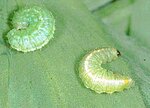South Dakota Extension forage field specialist
Winter wheat is near heading or heading out in many parts of South Dakota. As flowering nears, the main pest concern is fusarium head blight (head scab), which is a fungal pathogen that produces a …
This item is available in full to subscribers.
To continue reading, you will need to either log in to your subscriber account, below, or purchase a new subscription.
Please log in to continue |


Winter wheat is near heading or heading out in many parts of South Dakota. As flowering nears, the main pest concern is fusarium head blight (head scab), which is a fungal pathogen that produces a mycotoxin that can pose a significant livestock health risk and can cause wheat grain yield loss.
Now (heading) is the time to scout fields and consider a preventative fungicide application for head scab at early flowering. Wheat is most susceptible to Fusarium head blight (scab) around flowering because the pathogen that causes scab infects wheat through the flower. If you experience hot weather at heading, this can accelerate the time between heading and flowering to just a couple days, so it’s vital to check fields daily. If temps remain cool, this is still good practice as flowering can sneak up quicly. Timing for effective fungicide application is very important to achieve reliable crop protection.
Deciding whether to apply fungicides can be a difficult decision. To avoid scab, applying the right product at the ideal timing can protect your crop from significant yield loss; however, economics should also be taken into consideration. If conditions are wet at flowering and temperatures are high, you likely have a high risk of head blight infection. If conditions are dry and temperatures are moderate, there may be a lower risk, but inoculum in nearby fields or crop residues may still provide a source for infection.
Two tools are available to help assess head scab risk, the Fusarium Risk Tool provided by the national Fusarium Head Blight Prediction Center (https://www.wheatscab.psu.edu/), and the Small Grains Disease Tool, hosted by the South Dakota Mesonet (https://climate.sdstate.edu/tools/smallgrains/). Both of these tools provide the likelihood rating for risk of scab based upon date, nearest weather station data, variety susceptibility ratings, flowering date, and other factors. Consider using these tools to aid in deciding whether to apply a fungicide for scab prevention, and what fungicide may suit your situation the best.
Alfalfa weevils are known to be active near first cutting. According to our SDSU entomology team, current weevil activity is slower than growing degree day estimations — cool evening temperatures are likely the cause. However, southern counties likely will experience higher levels of activity first, as the insects move north during the growing season. Watch for alfalfa weevil activity update articles by Adam Varenhorst in our Pest & Crop Newsletter this season or at extension.sdstate.edu. Although weevil activity may be later than expected, it’s still important to be sure you’re watching alfalfa fields for insect damage to avoid economic losses.
Fields with heavy weevil defoliation often appear white or light-brown. Weevils can do a great amount of damage to an alfalfa crop in a hurry and many producers chose to cut hay slightly early when weevil activity is present, in order to slow crop damage. This method is a viable management strategy to reduce feeding, but does not guarantee that weevils will not remain in the field or return. In fact, they often continue eating on windrows as they dry.
Previous research has shown significant stunting of alfalfa when weevils continue feeding on alfalfa stubble following cutting and harvest. Weevils feed mainly on the terminal buds of the plant, causing stunting. This is why scouting field is highly important, especially if weevils were present in your field early in the season.
Alfalfa weevil activity estimates are based on growing degree day accumulation; however, this isn’t always 100% accurate and weevil development can deviate slightly from the expected calculations. To scout fields moving forward, the best method is to use a sweep net and 5-gallon pail. Once you have determined weevil presence, population density needs to be determined. To scout, walk in a "Z" pattern across the field and randomly sample a total of 30 plants (pull plants out gently or cut at soil surface). Tap each plant against the inside of the 5-gallon pail to dislodge larvae as you sample. Count the number of larvae in the bucket and determine the height of the alfalfa plant. Once 30 samples have been taken, calculate the average number of larvae per plant and average plant height of the sample set. Using this information, the economic threshold to spray insecticide for weevils can be determined using SDSU Recommendations that can be found by searching “Scout Alfalfa Weevils” at extension.sdstate.edu and using the appropriate table to determine your economic spray threshold.